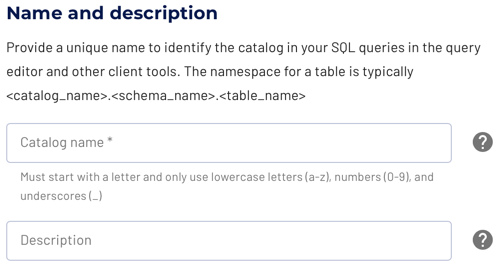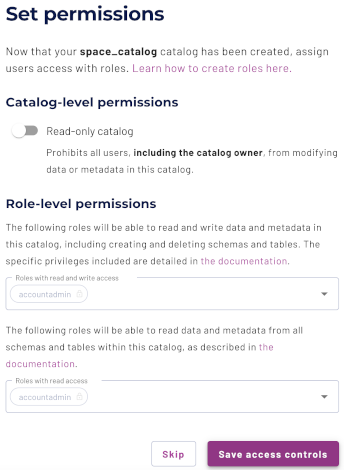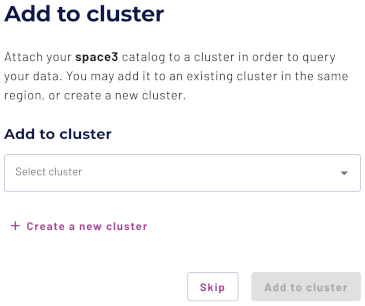MongoDB catalogs #
Use a MongoDB catalog to configure access to a MongoDB or MongoDB Atlas data platform.
Follow these steps to create a catalog for MongoDB:
- In the navigation menu, select Data, then Catalogs.
- Click Create catalog.
- On the Create a catalog pane, click the MongoDB icon.
- Configure the catalog as prompted in the dialog.
- Test the connection.
- Connect the catalog.
- Set any required permissions.
- Add the new catalog to a cluster.
The following sections provide more detail for creating MongoDB catalog connections.
Getting started with MongoDB #
When configuring a MongoDB catalog in Starburst Galaxy, there are different access characteristics depending on whether your deployment uses a single cloud provider region or multiple cloud provider regions:
- If your MongoDB instance uses a single node deployment or configures replica sets across the same cloud provider region, then the Starburst Galaxy catalog supports both read and write access.
- If your MongoDB instance configures replica sets across multiple cloud provider regions, then the Galaxy catalog supports read-only access.
For a MongoDB Atlas federated database instance, the Starburst Galaxy catalog supports read-only access. Additionally, Starburst Galaxy supports tables with all rows conforming to same schema.
Select a cloud provider #
The Cloud provider configuration is necessary to allow Starburst Galaxy to correctly match catalogs and clusters.
The data source configured in a catalog, and the cluster must operate in the same cloud provider and region for performance and cost reasons.

Define catalog name and description #
The Catalog name is visible in the query editor and other clients. It is used to identify the catalog when writing SQL or showing the catalog and its nested schemas and tables in client applications.
The name is displayed in the query editor, and in the output of a SHOW
CATALOGS command.
It is used to fully qualify the name of any table in SQL queries following the
catalogname.schemaname.tablename syntax. For example, you can run the
following query in the sample cluster without first setting the catalog or
schema context: SELECT * FROM tpch.sf1.nation;.
The Description is a short, optional paragraph that provides further details about the catalog. It appears in the Starburst Galaxy user interface and can help other users determine what data can be accessed with the catalog.

Multiple connections #
The MongoDB catalog can only access a single MongoDB database within a single catalog. If you have multiple MongoDB databases, or want to connect to multiple MongoDB instances, you must configure additional instances of the MongoDB catalog.
Configure the connection #
Read further to learn about each supported connection method. The following sections detail the setup for the supported cloud providers.
-
Connect directly
The connection to the database requires a username, password authentication, and the details necessary to connect to the database server, typically hostname or IP address and port. -
Connect via SSH tunnel
A connection to the database can be established directly, if the Starburst Galaxy IP range/CIDR is allowed to connect.If the database is only accessible inside the virtual private cloud (VPC) of the cloud provider, you can use an SSH tunnel with a bastion host in the VPC.
-
PrivateLink Starburst Galaxy supports AWS PrivateLink for MongoDB catalogs.
MongoDB configuration #
Mind the following to ensure a successful connection to your MongoDB or Atlas data platform:
-
If you are using MongoDB Atlas in AWS and Direct connectivity, you must whitelist all IPs from the Galaxy allow list for AWS, Azure, and GCP.
-
If you are using MongoDB Atlas and wish to connect directly, add the Starburst Galaxy IP Range/CIDR for your region to the Atlas IP Access List.
To configure the connection, provide the following details:
- Database username: specify a user with sufficient access rights to allow the desired querying. For example, if you only want to query data for analytics, the user does not need to have write access.
- Database password: specify the password for the user.
- Hosts: specify either a single host or multiple hosts if using MongoDB
replica sets. For example, for a single MongoDB server with the connection
string
mongodb://user:password@host1:port1, the host value ishost1:port1. For a MongoDB cluster using replica sets with the connection stringmongodb://user:password@host1:port1,host2:port2,host3:port3/, the host value ishost1:port1,host2:port2,host3:port3. If you do not provide a port, MongoDB uses port27017by default. - Use DNS seed list (SRV): defaults to false. Enable this setting if you are
using a DNS Seed
List.
The DNS seed list connection format begins with the prefix
mongodb+srvinstead ofmongodb. In the connection stringmongodb+srv://cluster.example.mongodb.net/myFirstDatabase, the host value iscluster.example.mongodb.net. Only a single host is allowed when using themongodb+srvprotocol. - Use TLS: defaults to true. Enable this setting if you are connecting to a MongoDB instance with TLS.
- Federated database: defaults to false. Enable this setting if you are connecting to a MongoDB Atlas Federated Database. Use the connection string specific to your federated database instance. Contact your Starburst account team for support.
Test the connection #
Once you have configured the connection details, click Test connection to confirm data access is working. If the test is successful, you can save the catalog.
If the test fails, look over your entries in the configuration fields, correct any errors, and try again. If the test continues to fail, Galaxy provides diagnostic information that you can use to fix the data source configuration in the cloud provider system.
Another way to resolve a connection failure is by temporarily opening traffic to the internet. To do this, add 0.0.0.0/0 to the MongoDB Atlas IP Access List. Once you receive a successful connection notification, delete 0.0.0.0/0 from the list.
Connect catalog #
Click Connect catalog, and proceed to set permissions where you can grant access to certain roles.
Set permissions #
This optional step allows you to configure read-only access or full read and write access to the catalog.
Use the following steps to assign read-only access to all roles:
- Select the Read-only catalog switch to grant a set of roles read-only access to the catalog’s schemas, tables, and views.
- Next, use the drop-down menu in the Role-level permissions section to specify the roles that have read-only access.
- Click Save access controls.
You can specify read-only access and read-write access separately for different sets of roles. That is, one set of roles can get full read and write access to all schemas, tables, and views in the catalog, while another set of roles gets read-only access.
Use the following steps to assign read/write access to some or all roles:
- Leave the Read-only catalog switch cleared.
- In the Role-level permissions section:
- Expand the drop-down menu in the Roles with read and write access field and select one or more roles to grant read and write access to.
- Expand the drop-down menu in the Roles with read access field and select one or more roles from the list to grant read-only access to.
- Click Save access controls.

Add to cluster #
You can add your catalog to a cluster later by editing a cluster. Click Skip to proceed to the catalogs page.
Use the following steps to add your catalog to an existing cluster or create a new cluster in the same cloud region:
- In the Add to cluster section, expand the menu in the Select cluster field.
- Select one or more existing clusters from the drop down menu.
- Click Create a new cluster to create a new cluster in the same region, and add it to the cluster selection menu.
-
Click Add to cluster to view your new catalog’s configuration.

SQL support #
The catalog provides read access and write access to data and metadata in MongoDB. It supports the following features:
- Globally available statements
- Read operations
- Write operations:
- Data management:
- Schema and table management:
The following sections provide MongoDB catalog-specific information regarding SQL support.
Schema and table management details #
The catalog supports the following ALTER TABLE operations:
ALTER TABLE RENAME TOALTER TABLE ADD COLUMNALTER TABLE DROP COLUMN
Other uses of ALTER TABLE are not supported.
Is the information on this page helpful?
Yes
No
